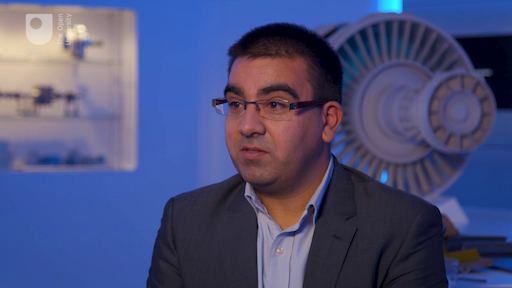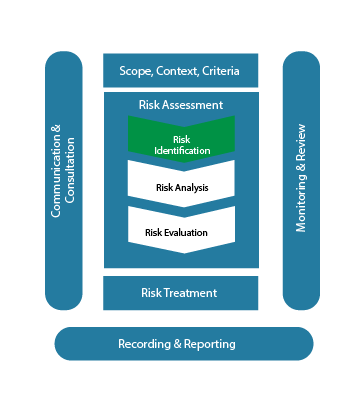Session 3: Risk identification
Introduction
Watch Video 1, which covers when to start risk management.

Transcript: Video 1 When to start risk management
In Session 1 you looked at some definitions of risk. Revisit these for a moment:
A situation involving exposure to danger, the possibility that something unpleasant or unwelcome will happen, a person or thing regarded as a threat or likely source of danger, a possibility of harm or damage against which something is insured, a person or thing regarded as likely to turn out well or badly in a particular context or respect, the possibility of financial loss.
OED source [Tip: hold Ctrl and click a link to open it in a new tab. (Hide tip)]
So, as discussed in Session 1, a risk must have some degree of uncertainty. In the risk process identifying that uncertainty takes place in the risk identification phase:
Activity 1 Uncertainty statements
a.
In the last 5 years a supplier has only had a delivery issue once and this was due to factors outside of their control.
b.
There is a possibility that a key supplier may fail, leading to raw materials not being supplied.
c.
Cyber actors are increasingly looking outside of their primary targets for ways in, including the supply chain.
The correct answer is b.
a.
A competitor has just launched a new product ahead of us that is more advanced and it looks like it uses our intellectual property.
b.
At some point a technology company will create an offering that will side step our main product range and could leave us as a niche player.
c.
Because of strong competition the business might not win the contract with a big customer.
The correct answer is c.
a.
Our main warehouse is built on a flood plain, there have been two floods in the town in the last 20 years.
b.
A fire could break out in one of our facilities, if we don’t take the right precautions.
c.
Automation of the workforce is something we will have to manage in the next 10–20 years.
The correct answer is b.
a.
There is a chance that the government may introduce new regulations that would limit how the company could trade.
b.
There has been a coup in a country we operate in, leading to civil unrest in major towns and cities.
c.
Climate change will impact the market for our product, how we produce and where we can sell.
The correct answer is a.
a.
Sometimes our sales team make mistakes and this, if not properly managed, can lead to errors in the order processing system.
b.
There is an error in our order fulfilment system that leads to some lines going to the wrong dispatch centre; we don’t fully understand the scale of this yet.
c.
The internet will change how our customers place orders in the future.
The correct answer is a.
Answer
| These were the uncertainties (simple risk statements) all focused around tangible activities that the company presently faces | These were ‘facts’ that related to ‘incidents’ (either recent or historic) that may require action or give an insight into risks that may need to be managed | These are sometimes referred to as ‘concerns’ that are potential areas for risk where the concepts are broad and the company may want to undertake further work to understand the risks faced. These are often referred to as emerging risks. (See horizon scanning in Session 8.) | |
|---|---|---|---|
| Question 1 | There is a possibility that a key supplier may fail, leading to raw materials not being supplied. | In the last 5 years a supplier has only had a delivery issue once and this was due to factors outside of their control. | Within the next 10 years we will have to shift our supply chain away from the current raw materials to remain cost competitive. |
| Question 2 | Because of strong competition the business might not win the contract with a big customer. | A competitor has just launched a new product ahead of us that is more advanced and it looks like it uses our intellectual property. | At some point a technology company will create an offering that will side step our main product range and could leave us as a niche player. |
| Question 3 | A fire could break out in one of our facilities if we don’t take the right precautions. | Our main warehouse is built on a flood plain, there have been two floods in the town in the last 20 years. | Automation of the workforce is something we will have to manage in the next 10–20 years. |
| Question 4 | There is a chance that the government may introduce new regulations that would limit how the company could trade. | There has been a coup in a country we operate in, leading to civil unrest in major towns and cities. | Climate change will impact the market for our product, how we produce and where we can sell. |
| Question 5 | Sometimes our sales team make mistakes and this, if not properly managed, can lead to errors in the order processing system. | There is an error in our order fulfilment system that leads to some lines going to the wrong dispatch centre; we don’t fully understand the scale of this yet. | The internet of things will change how our customers place orders in he future. |
By the end of this session, you should be able to:
- construct a meaningful risk statement (Cause / Event / Consequence)
- understand methods of identifying risk – brainstorming, interviews, checklists, PESTLE, SWOT
- understand different types of risk
- understand risk registers.
Now begin Session 3.

